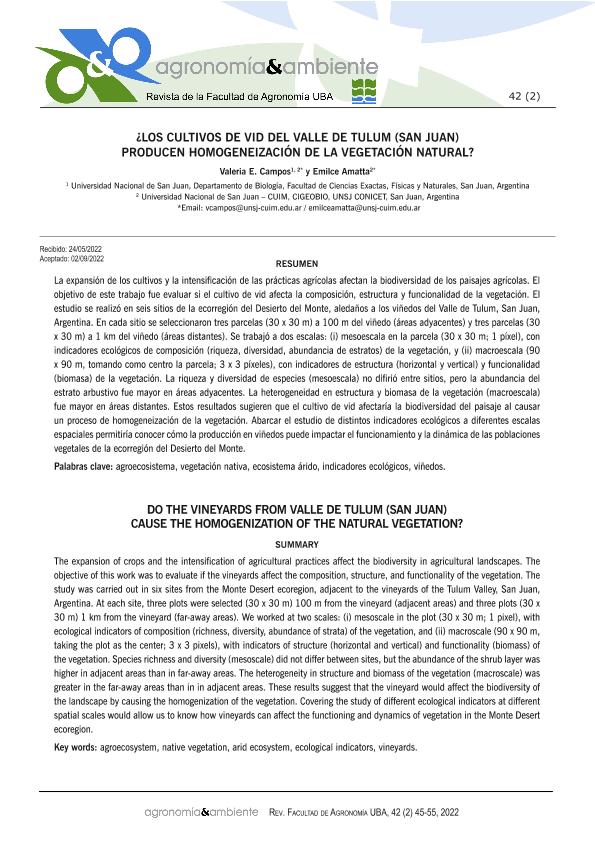Mostrar el registro sencillo del ítem
dc.contributor.author
Campos, Valeria Evelin

dc.contributor.author
Amatta, Emilce del Valle

dc.date.available
2023-07-25T16:49:55Z
dc.date.issued
2022-12
dc.identifier.citation
Campos, Valeria Evelin; Amatta, Emilce del Valle; ¿Los cultivos de vid del valle de Tulum (San Juan) producen homogeneización de la vegetación natural?; Universidad de Buenos Aires. Facultad de Agronomía; Agronomía & Ambiente; 42; 2; 12-2022; 45-55
dc.identifier.issn
2344-9039
dc.identifier.uri
http://hdl.handle.net/11336/205393
dc.description.abstract
La expansión de los cultivos y la intensificación de las prácticas agrícolas afectan la biodiversidad de los paisajes agrícolas. El objetivo de este trabajo fue evaluar si el cultivo de vid afecta la composición, estructura y funcionalidad de la vegetación. El estudio se realizó en seis sitios de la ecorregión del Desierto del Monte, aledaños a los viñedos del Valle de Tulum, San Juan, Argentina. En cada sitio se seleccionaron tres parcelas (30 x 30 m) a 100 m del viñedo (áreas adyacentes) y tres parcelas (30 x 30 m) a 1 km del viñedo (áreas distantes). Se trabajó a dos escalas: (i) mesoescala en la parcela (30 x 30 m; 1 píxel), con indicadores ecológicos de composición (riqueza, diversidad, abundancia de estratos) de la vegetación, y (ii) macroescala (90 x 90 m, tomando como centro la parcela; 3 x 3 píxeles), con indicadores de estructura (horizontal y vertical) y funcionalidad (biomasa) de la vegetación. La riqueza y diversidad de especies (mesoescala) no difirió entre sitios, pero la abundancia del estrato arbustivo fue mayor en áreas adyacentes. La heterogeneidad en estructura y biomasa de la vegetación (macroescala) fue mayor en áreas distantes. Estos resultados sugieren que el cultivo de vid afectaría la biodiversidad del paisaje al causar un proceso de homogeneización de la vegetación. Abarcar el estudio de distintos indicadores ecológicos a diferentes escalas espaciales permitiría conocer cómo la producción en viñedos puede impactar el funcionamiento y la dinámica de las poblaciones vegetales de la ecorregión del Desierto del Monte.
dc.description.abstract
The expansion of crops and the intensification of agricultural practices affect the biodiversity in agricultural landscapes. The objective of this work was to evaluate if the vineyards affect the composition, structure, and functionality of the vegetation. The study was carried out in six sites from the Monte Desert ecoregion, adjacent to the vineyards of the Tulum Valley, San Juan, Argentina. At each site, three plots were selected (30 x 30 m) 100 m from the vineyard (adjacent areas) and three plots (30 x 30 m) 1 km from the vineyard (far-away areas). We worked at two scales: (i) mesoscale in the plot (30 x 30 m; 1 pixel), with ecological indicators of composition (richness, diversity, abundance of strata) of the vegetation, and (ii) macroscale (90 x 90 m, taking the plot as the center; 3 x 3 pixels), with indicators of structure (horizontal and vertical) and functionality (biomass) of the vegetation. Species richness and diversity (mesoscale) did not differ between sites, but the abundance of the shrub layer was higher in adjacent areas than in far-away areas. The heterogeneity in structure and biomass of the vegetation (macroscale) was greater in the far-away areas than in in adjacent areas. These results suggest that the vineyard would affect the biodiversity of the landscape by causing the homogenization of the vegetation. Covering the study of different ecological indicators at different spatial scales would allow us to know how vineyards can affect the functioning and dynamics of vegetation in the Monte Desert ecoregion.
dc.format
application/pdf
dc.language.iso
spa
dc.publisher
Universidad de Buenos Aires. Facultad de Agronomía

dc.rights
info:eu-repo/semantics/openAccess
dc.rights.uri
https://creativecommons.org/licenses/by-nc/2.5/ar/
dc.subject
AGROECOSISTEMA
dc.subject
VEGETACIÓN NATIVA
dc.subject
ECOSISTEMA ÁRIDO
dc.subject
INDICADORES ECOLOGÍCOS
dc.subject.classification
Conservación de la Biodiversidad

dc.subject.classification
Ciencias Biológicas

dc.subject.classification
CIENCIAS NATURALES Y EXACTAS

dc.title
¿Los cultivos de vid del valle de Tulum (San Juan) producen homogeneización de la vegetación natural?
dc.title
Do the vineyards from valle de Tulum (San Juan) cause the homogenization of the natural vegetation?
dc.type
info:eu-repo/semantics/article
dc.type
info:ar-repo/semantics/artículo
dc.type
info:eu-repo/semantics/publishedVersion
dc.date.updated
2023-07-06T11:10:15Z
dc.journal.volume
42
dc.journal.number
2
dc.journal.pagination
45-55
dc.journal.pais
Argentina

dc.journal.ciudad
Ciudad Autónoma de Buenos Aires
dc.description.fil
Fil: Campos, Valeria Evelin. Consejo Nacional de Investigaciones Científicas y Técnicas. Centro Científico Tecnológico Conicet - San Juan. Centro de Investigaciones de la Geosfera y Biosfera. Universidad Nacional de San Juan. Facultad de Ciencias Exactas Físicas y Naturales. Centro de Investigaciones de la Geosfera y Biosfera; Argentina
dc.description.fil
Fil: Amatta, Emilce del Valle. Consejo Nacional de Investigaciones Científicas y Técnicas. Centro Científico Tecnológico Conicet - San Juan. Centro de Investigaciones de la Geosfera y Biosfera. Universidad Nacional de San Juan. Facultad de Ciencias Exactas Físicas y Naturales. Centro de Investigaciones de la Geosfera y Biosfera; Argentina
dc.journal.title
Agronomía & Ambiente
dc.relation.alternativeid
info:eu-repo/semantics/altIdentifier/url/http://agronomiayambiente.agro.uba.ar/index.php/AyA/article/view/217
Archivos asociados
